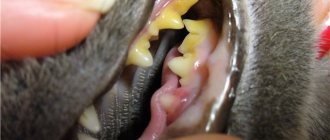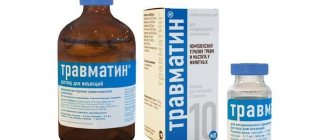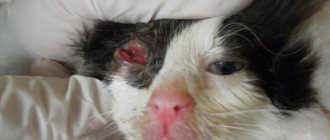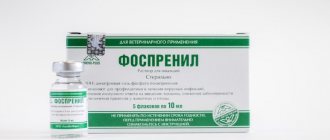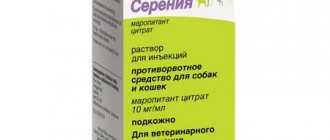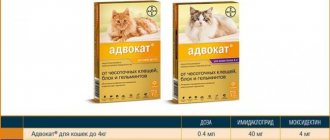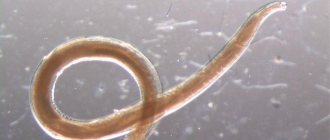- VetConsultPlus
- Informational portal
- Veterinary drug
- Drug name: Vetom
- Latin name: Vetom
- Group: probiotics
- Target species: cats and other animal species
- Active ingredient: live cultures of Bacillus subtilis
- 1 g of the drug contains: living microbial cells of Bacillus subtilis bacteria - at least 1 × 10 to the 6th power of colony-forming units
- Form: powder for enteral use (oral and rectal)
- Dose: 50 mg/kg
Compound
Vetom contains a dry mass of live spore-forming bacteria Bacillus subtilis strain DSM 32424, as well as auxiliary substances - powdered sugar and starch.
1 g of the drug contains:
- living microbial cells of Bacillus subtilis bacteria - at least 1 × 106 CFU (colony-forming units).
In appearance, Vetom for cats is a fine white powder, odorless, soluble in water, with the formation of a white precipitate. The shelf life of the drug is 4 years from the date of release, subject to storage and transportation conditions. After the expiration date, the drug is not suitable for use. After opening the initial packaging, the drug is stored at room temperature for 15 days.
Forms of release of the medicinal product for veterinary use: powder for oral and rectal use.
According to the instructions for veterinary use, the drug is packaged in bags made of laminated paper or polymer waterproof materials or in polymer jars:
- 1.0 g each (1 dosage)
- 2.0 g (2 doses)
- 5.0 g (5 servings)
- 10.0 g (10 doses)
- 50.0 g (50 doses)
- 100.0 g (100 doses)
- 300.0 g (300 doses)
- 500.0 g (500 doses)
Contraindications and side effects of the drug
Side effects almost never occur if the dosage is strictly followed. In rare cases, side effects appear from taking Vetom powder. Cats may experience diarrhea and flatulence, or increased pain in inflamed organs.
There are very few contraindications to using Vetom. This medication may cause allergies in sensitive animals.
Important! The drug should not be taken by cats that have developed allergies, as well as those with diabetes, pregnant or lactating women.
Vetom 4
Vetom is packaged in bags with an internal polymer coating or in polymer jars:
- 1.0 kg (1000 doses)
- 1.0 kg each (1000 servings)
- 2.0 kg (2000 doses)
- 5.0 kg (5000 servings)
Vetom is packaged in bags made of polyethylene or polymer combined waterproof materials:
- 1.0 kg (1000 dosages)
- 2.0 kg (2000 servings)
- 5.0 kg (5000 doses)
Vetom-1 is packaged in cardboard drums:
- 1.0 kg (1000 doses)
- 2.0 kg (2000 dosages)
- 5.0 kg (5000 doses)
- 10.0 kg (10,000 doses)
- 15.0 kg (15,000 doses)
- 20.0 kg (20,000 doses)
Vetom is stored and transported in the manufacturer's packaging in a dry place, protected from light, at a temperature of 0 °C to 30 °C.
Vetom, a medicinal product for veterinary use, should be stored out of the reach of children. Available without a prescription.
Cans and packages of Vetom without labels, with an expired expiration date, with the integrity and/or tightness of the packaging, containing foreign impurities, with a discoloration, as well as remnants of the drug that have not been used within 15 days after opening the original packaging, are subject to rejection and subsequent disposal with household waste.
Price
The cost of Vetom 1.1 is low. The price for one 5 g sachet varies between 15-30 rubles. At different points, retail markups may be added to the recommended price from the Russian manufacturer.
Vetom for cats and kittens
Visit the profile section of our Medical Examination forum or leave your feedback in the comments below. More opinions means more useful information, it will be useful to someone. If there are good and interesting videos on the topic of the article, write and I will insert them into this publication.
Pharmacological properties of Vetom-1 for cats
According to the instructions, the pharmacotherapeutic group of the medicinal product for veterinary use: probiotic. The bacteria Bacillus subtilis strain DSM 32424 secrete antibiotic-like substances, enzymes, and other biologically active substances in the intestines of animals, under the influence of which they normalize:
- intestinal biocenosis
- acidity of the environment
- digestion
- iron absorption and metabolism
- calcium absorption
- fat metabolism
- protein metabolism
- carbohydrate metabolism
- triglyceride metabolism
- amino acid metabolism
- exchange of dipeptides, sugars
- bile salt metabolism
Vetom for cats stimulates cellular and humoral immunity factors, increases the resistance of animals and poultry to infection by viral and bacterial agents.
Therapeutic effect
Vetom for cats has many different healing properties:
- Stimulates the activity of phagocytes and lymphocytes to protect the immune system.
- Normalizes the level of acidity in the intestines and the state of its microflora.
- Normalizes metabolism.
- Eliminates inflammatory processes.
Vetom is packaged in jars of 50 g, 100 g, 500 g, 1000 g
Application procedure
Vetom is used for cats strictly according to the instructions:
- to restore the body's natural immune resistance
- for intestinal disorders after long-term treatment with antibiotics
- in case of disruption of normal digestive processes
- when changing diets or when the quality of feed raw materials deteriorates
- prevention and treatment of dysbacteriosis
- associated with enzyme deficiency
- stimulation of growth and development of young animals
- increasing the safety and productivity of animals
There are no contraindications for the use of Vetom in cats.
No special precautions are required when working with the drug.
Possible use in pregnant cats, in animals during lactation, in the offspring of animals (young animals in the early postnatal period).
- For prophylactic purposes, Vetom is administered to cats with water and food at a dose of 50 mg/kg of live weight once a day for 15-20 days.
- The rectal route of administration of Vetom is allowed at a dose of 50 mg/kg of live weight once a day for 15-20 days. The drug is diluted with warm boiled water and administered to the animal after a cleansing enema.
- According to the instructions, for therapeutic purposes the drug is prescribed to cats individually at a dose of 50 mg/kg of live weight 2 times a day with an interval of 8-10 hours until the clinical signs of the disease disappear. In severe cases of the disease, it is allowed to increase the frequency of administration to 4 times a day with an interval of 6 hours.
- In order to correct immunodeficiency states in cats, Vetom is prescribed 1-2 times a day at a dose of 50 mg/kg live weight for 5-10 days.
- When used as a solution, it is necessary to use a drinking system.
- No side effects have been identified with Vetom; there are no adverse reactions when using the medicinal product for veterinary use Vetom 1.
- There were no symptoms of toxicosis or other adverse reactions in case of an overdose of the drug. No assistance is required in case of overdose.
- According to the instructions for use, it is prohibited to prescribe Vetom simultaneously with antibiotics and sulfonamides. When used in dry bulk feed, mixing is carried out in accordance with the regulations established for feed production lines. Do not expose the drug to temperatures above 100 °C for more than 10 minutes.
- The specific effects of the drug upon first use or its withdrawal have not been established.
- Special measures are not provided for skipping one or more doses of the drug; the course of treatment and prevention is continued.
Appointments
The product will help the fragile body cope with health problems.
The veterinary drug “Vetom” is recommended to be given to cats if they are infected with viruses, bacteria, as well as with pathologies of the digestive tube, dysbacteriosis and immunodeficiency. Taking an immunomodulator is important for kittens who suffer from diarrhea, obesity, allergies and have poor metabolism. With the help of Vetom, hormonal imbalances are treated, in particular those that arise after taking medications, solve digestive problems, and speed up recovery after operations. The probiotic will also be useful for a kitten that has encountered coccidiosis, dysentery and salmonellosis, as well as hepatitis, parainfluenza, rhinotracheitis and enteritis.
Learn about essential antimicrobials in animals
- Trichopolum instructions for veterinary medicine
- Instructions for the use of the antibiotic Baytril in animals
- Instructions for use of metronide
- Instructions for ceftriaxone preparations for animals
- Use of Metrogyl in veterinary medicine
- Instructions for doxycycline in animals
- Metronidazole (Metronidazole) for animals (instructions for use in veterinary medicine, doses, indications and contraindications)
- Atovaquone (ATOVAQUONE)
- Azithromycin, instructions for animal therapy
^Top
General information
As a formative substance, the preparation uses corn syrup in the form of sublimate, starch and powdered sugar. The drug is available in the following packaging - bags from 2 to 500g or polymer jars of 50-5000g.
The drug is stored at a temperature not exceeding 300C. No more than two years from the date of production. Open containers are stored for no more than two weeks. The dissolved drug must be used immediately; further storage is unacceptable.
Manufacturer Vetoma 1 NPF Research Center LLC (Russia).
Vetom 2.5 g (for animals): properties
Bacillus subtilis (bacillus subtilis) is a well-studied species of gram-positive, spore-forming aerobic bacteria from the genus Bacillus. The genus Bacillus includes more than 3,000 different bacteria. For the first time, preparations with Bacillus subtilis began to be used by Wehrmacht specialists during the Second World War in the treatment and prevention of dysentery in the military. Specialists of the Soviet Union also became interested in these microorganisms due to their ability to actively suppress the growth and development of pathogenic, conditionally pathogenic, putrefactive microflora and stimulate the body's immune response. For many decades, Bacillus subtilis has been studied by leading microbiology institutes in our country, where the first bacteria beneficial to the body of animals and humans were selected. Recombinant strain Bacillus subtilis VKPM B 7048 and Bacillus licheniformis strain VKPM B 7038 are resistant to digestive juice and enzymes of the gastrointestinal tract of mammals. When they enter the intestines, bacterial spores are converted into vegetative forms and rapidly colonize the gastrointestinal tract. In the intestine, Bacillus subtilis begins to produce enzymes (amylase, lipase, protease), human leukocyte interferon-2 and other important substances that help normalize intestinal microbiocinosis (the totality of populations of various types of microorganisms living in the gastrointestinal tract), improve metabolism and tissue regeneration processes . Bacillus subtilis has a beneficial effect on the animal's immune system, helps to increase the phagocytic activity of the blood to the physiological norm, and increases the amount of endogenous interferon. Thanks to this, the animal’s body’s resistance to the effects of negative environmental factors increases, as well as the body’s resistance to stress increases, and the feed conversion ratio decreases due to the ability of Bacillus subtilis to synthesize various enzymes. Feed conversion is the ratio of the amount of feed consumed to a unit of product obtained, for example, to 1 kg of weight gain or 1 liter of milk. The lower the conversion ratio, the less feed needs to be spent on livestock production. Bacillus subtilis also protects the animal's body from the appearance of dysbacteriosis, as it is an antagonist of pathogenic and opportunistic microorganisms, including salmonella, proteus, streptococcus, staphylococcus, yeast and so on. Bacillus subtilis, due to its high enzymatic activity, helps improve digestion processes, improves the absorption of nutrients in the gastrointestinal tract of the animal, and also produces antibiotics and acidifies the environment, which means it inhibits the processes of rotting and fermentation in the intestines.
